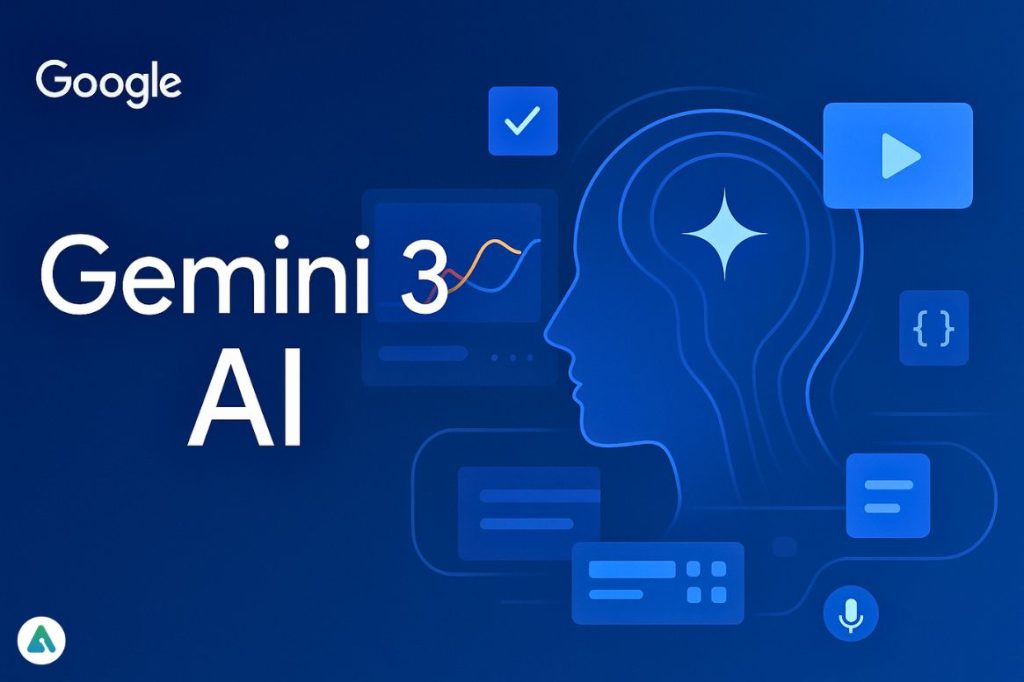Google just unveiled Gemini 3, and make no mistake — this isn’t just another update. This is an AI model that thinks, creates, and interacts in ways that feel almost human. It’s like moving from talking to a clever assistant to collaborating with a teammate who never sleeps, never forgets, and can juggle multiple media at once.
Google Gemini 3 AI promises to blur the line between tool and partner, and it’s designed to change how we learn, work, and even explore ideas.
Thinking Beyond Words
Gemini 3 doesn’t just answer questions. It weighs context, intention, and nuance, producing insights that feel thoughtful rather than mechanical. You can ask it a multi-layered question — like “What’s the likely economic impact if renewable energy adoption doubles in the next decade?” — and it can analyze data, trends, and projections to provide a considered response.
It’s not just smart; it’s aware of why a question matters. That’s a subtle difference that makes interactions feel less like reading a script and more like talking to a colleague who really understands your challenge.
Seeing AI in Action: The Generative UI
One of the standout innovations is the Generative UI, which turns AI responses into interactive visual experiences. Imagine asking Gemini 3 to design a marketing dashboard — instead of a static chart, it delivers a live interface where you can adjust filters, simulate scenarios, or compare metrics in real time.
Or picture a science teacher asking Gemini 3 to demonstrate chemical reactions. Students don’t just get an answer — they get a virtual lab where they can tweak variables, test ideas, and see outcomes unfold.
This is more than flashy visuals; it’s a new way to interact with information. Instead of consuming outputs, you’re exploring, experimenting, and learning alongside the AI.
Deep Think Mode: AI That Tackles Complexity
Google has also introduced Deep Think, a mode specifically for multi-step reasoning. It’s like watching someone solve a Rubik’s cube — Gemini 3 can plan each step, check its logic, and adjust as it goes.
For example, a researcher could ask Gemini 3 Deep Think to cross-analyze datasets from different countries, consider policy impacts, and then outline a detailed, actionable report. Deep Think isn’t just producing answers; it’s navigating complexity, reasoning through layers of information that would trip up simpler models.
Multimodal Intelligence: Seeing, Hearing, and Doing
Gemini 3 isn’t confined to text. It thrives across images, video, audio, and code.
-
Text + Images: Ask it to visualize a futuristic city skyline, and it can generate layouts and diagrams that make architectural ideas tangible.
-
Text + Video: Summarize or generate video content, turning concepts into visual stories.
-
Code Generation: Write, debug, and optimize code — then run it. Gemini 3 can become a real-time programming partner.
-
Audio: Transcribe, analyze, or produce human-like voice output for presentations or content creation.
In other words, Gemini 3 can jump between mediums seamlessly, turning abstract prompts into concrete, interactive outputs.
For Developers: Antigravity and AI Studio
Google isn’t just serving end-users — it’s handing developers a playground. With Antigravity and AI Studio, developers can build agentic applications where Gemini 3:
-
Plans tasks autonomously
-
Writes and tests code
-
Self-corrects and learns from feedback
-
Generates interactive interfaces on the fly
Think of it like having a collaborator who can prototype, debug, and refine while you focus on bigger-picture decisions. This shifts AI from task automation to active co-creation, opening possibilities for startups, research teams, and tech innovators.
Reimagining Search
Gemini 3 is also rolling into Google Search AI Mode. No more plain lists of links — now search can provide:
-
Interactive results with simulations and real-time visuals
-
Step-by-step guidance on complex tasks, from filing taxes to planning travel
-
Dynamic answers that feel like a conversation instead of a report
This is a search as a collaborative partner, not a static tool. It’s a glimpse of what the future of information might look like: responsive, exploratory, and adaptive.
Safety, Ethics, and Trust
With great reasoning comes great responsibility. Google has implemented extensive safeguards to:
-
Reduce hallucinations and misinformation
-
Limit sycophantic or biased outputs
-
Make reasoning transparent
-
Resist malicious prompt manipulation
Even so, giving AI the ability to reason, interact, and simulate real-world outcomes raises ethical and practical questions. How much should we trust AI’s judgment? How do we balance speed, accuracy, and creativity? Gemini 3 opens doors — but also sparks debates.
Why Google Gemini 3 AI Matters
Gemini 3 isn’t just another AI release. It signals a paradigm shift:
-
From tools to collaborators: AI moves from executing commands to thinking alongside humans.
-
From static outputs to interactive experiences: Generative UI and multimodal reasoning turn information into something you can manipulate and explore.
-
From isolated capabilities to ecosystem platforms: Developers and users can build on top of Gemini 3, creating applications that are adaptive, intelligent, and interactive.
-
From answers to trust and ethics: As AI’s reasoning deepens, transparency and safety become crucial.
In short, Gemini 3 is less about being “smart” and more about being useful, collaborative, and insightful.
Looking Ahead
Google Gemini 3 shows what AI can become when it’s designed to reason, create, and collaborate. Whether you’re a developer, researcher, or casual user, its potential is enormous:
-
Developers can build self-improving applications and interactive simulations.
-
Students and educators can explore complex subjects with hands-on virtual tools.
-
Everyday users can get more than answers — they can get dynamic experiences tailored to their goals.
The future of AI isn’t just talking to machines. It’s working with them, exploring ideas, testing concepts, and creating in ways we couldn’t before. Gemini 3 is a glimpse into that future — and it’s only the beginning.
Visit: AIInsightsNews


